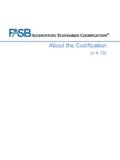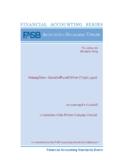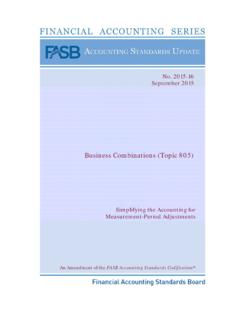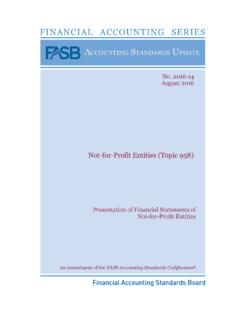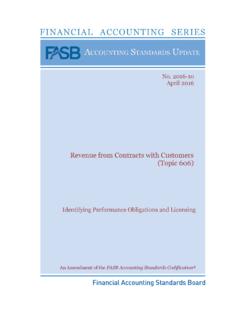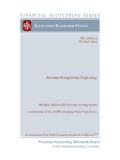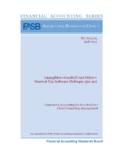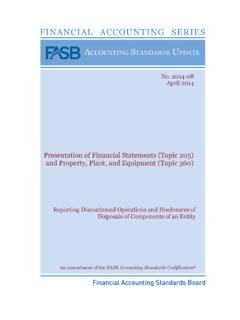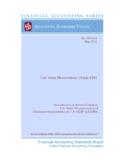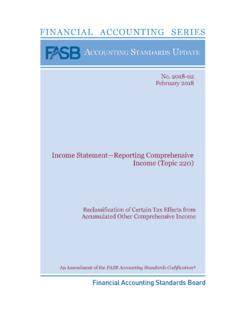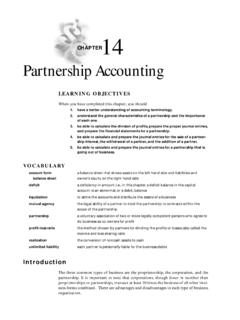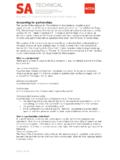Transcription of Financial Instruments—Overall (Subtopic 825-10)
1 Financial Instruments Overall (Subtopic 825-10) No. 2016-01 January 2016 Recognition and Measurement of Financial Assets and Financial liabilities An Amendment of the FASB accounting Standards Codification The FASB accounting Standards Codification is the source of authoritative generally accepted accounting principles (GAAP) recognized by the FASB to be applied by nongovernmental entities. An accounting Standards Update is not authoritative; rather, it is a document that communicates how the accounting Standards Codification is being amended. It also provides other information to help a user of GAAP understand how and why GAAP is changing and when the changes will be effective. For additional copies of this accounting Standards Update and information on applicable prices and discount rates contact: Order Department Financial accounting Standards Board 401 Merritt 7 PO Box 5116 Norwalk, CT 06856-5116 Please ask for our Product Code No.
2 ASU2016-01. Financial accounting SERIES (ISSN 0885-9051) is published quarterly by the Financial accounting Foundation. Periodicals postage paid at Norwalk, CT and at additional mailing offices. The full subscription rate is $255 per year. POSTMASTER: Send address changes to Financial accounting Standards Board, 401 Merritt 7, PO Box 5116, Norwalk, CT 06856-5116. | No. 425 Copyright 2016 by Financial accounting Foundation. All rights reserved. Content copyrighted by Financial accounting Foundation may not be reproduced, stored in a retrieval system, or transmitted, in any form or by any means, electronic, mechanical, photocopying, recording, or otherwise, without the prior written permission of the Financial accounting Foundation. Financial accounting Foundation claims no copyright in any portion hereof that constitutes a work of the United States Government.
3 An Amendment of the FASB accounting Standards Codification No. 2016-01 January 2016 Financial Instruments Overall (Subtopic 825-10) Recognition and Measurement of Financial Assets and Financial liabilities accounting Standards UpdateFinancial accounting Standards Board accounting Standards Update 2016-01 Financial Instruments Overall (Subtopic 825-10) Recognition and Measurement of Financial Assets and Financial liabilities January 2016 CONTENTS Page Numbers Summary .. 1 5 Amendments to the FASB accounting Standards Codification .. 7 184 Background Information and Basis for Conclusions .. 185 225 Amendments to the XBRL Taxonomy .. 226 1 Summary Why Is the FASB Issuing This accounting Standards Update (Update)? Before the global Financial crisis that began in 2008, both the Financial accounting Standards Board (FASB) and the International accounting Standards Board (IASB) began a joint project to improve and to achieve convergence of their respective standards on the accounting for Financial instruments.
4 The global economic crisis further highlighted the need for improvement in the accounting models for Financial instruments in today s complex economic environment. As a result, the main objective in developing this Update is enhancing the reporting model for Financial instruments to provide users of Financial statements with more decision-useful information. The amendments in this Update address certain aspects of recognition, measurement, presentation, and disclosure of Financial instruments. The Board also is addressing measurement of credit losses on Financial assets in a separate project. Who Is Affected by the Amendments in This Update? The amendments in this Update affect all entities that hold Financial assets or owe Financial liabilities .
5 What Are the Main Provisions? The amendments in this Update make targeted improvements to generally accepted accounting principles (GAAP) as follows: 1. Require equity investments (except those accounted for under the equity method of accounting or those that result in consolidation of the investee) to be measured at fair value with changes in fair value recognized in net income. However, an entity may choose to measure equity investments that do not have readily determinable fair values at cost minus impairment, if any, plus or minus changes resulting from observable price changes in orderly transactions for the identical or a similar investment of the same issuer. 2. Simplify the impairment assessment of equity investments without readily determinable fair values by requiring a qualitative assessment to identify impairment.
6 When a qualitative assessment indicates that impairment exists, an entity is required to measure the investment at fair value. 2 3. Eliminate the requirement to disclose the fair value of Financial instruments measured at amortized cost for entities that are not public business entities. 4. Eliminate the requirement for public business entities to disclose the method(s) and significant assumptions used to estimate the fair value that is required to be disclosed for Financial instruments measured at amortized cost on the balance sheet. 5. Require public business entities to use the exit price notion when measuring the fair value of Financial instruments for disclosure purposes. 6. Require an entity to present separately in other comprehensive income the portion of the total change in the fair value of a liability resulting from a change in the instrument-specific credit risk when the entity has elected to measure the liability at fair value in accordance with the fair value option for Financial instruments.
7 7. Require separate presentation of Financial assets and Financial liabilities by measurement category and form of Financial asset (that is, securities or loans and receivables) on the balance sheet or the accompanying notes to the Financial statements. 8. Clarify that an entity should evaluate the need for a valuation allowance on a deferred tax asset related to available-for-sale securities in combination with the entity s other deferred tax assets. How Do the Main Provisions Differ from Current Generally Accepted accounting Principles (GAAP) and Why Are They an Improvement? The amendments in this Update supersede the guidance to classify equity securities with readily determinable fair values into different categories (that is, trading or available-for-sale) and require equity securities (including other ownership interests, such as partnerships, unincorporated joint ventures, and limited liability companies) to be measured at fair value with changes in the fair value recognized through net income.
8 An entity s equity investments that are accounted for under the equity method of accounting or result in consolidation of an investee are not included within the scope of this Update. The amendments allow equity investments that do not have readily determinable fair values to be remeasured at fair value either upon the occurrence of an observable price change or upon identification of an impairment. The amendments also require enhanced disclosures about those investments. The amendments improve Financial reporting by providing relevant information about an entity s equity investments and reducing the number of items that are recognized in other comprehensive income. The amendments in this Update also simplify the impairment assessment of equity investments without readily determinable fair values by requiring assessment for impairment qualitatively at each reporting period.
9 That impairment assessment is 3 similar to the qualitative assessment for long-lived assets, goodwill, and indefinite-lived intangible assets. Upon determining that impairment exists, an entity should calculate the fair value of that investment and recognize as an impairment in net income any amount by which the carrying value exceeds the fair value of the investment. This impairment assessment reduces the complexity of the other-than-temporary impairment guidance entities were required to follow before the issuance of this Update, thereby reducing cost for preparers of the Financial statements. The amendments in this Update exempt all entities that are not public business entities from disclosing fair value information for Financial instruments measured at amortized cost.
10 In addition, for public business entities, the amendments supersede the requirement to disclose the methods and significant assumptions used in calculating the fair value of Financial instruments required to be disclosed for Financial instruments measured at amortized cost on the balance sheet. Those changes to GAAP result in less cost for preparers in a way that balances the need to provide users of Financial statements with information about the Financial instruments. The amendments in this Update require public business entities that are required to disclose fair value of Financial instruments measured at amortized cost on the balance sheet to measure that fair value using the exit price notion consistent with Topic 820, Fair Value Measurement. This change to GAAP eliminates the entry price method previously used by some entities for disclosure purposes for some Financial assets.
